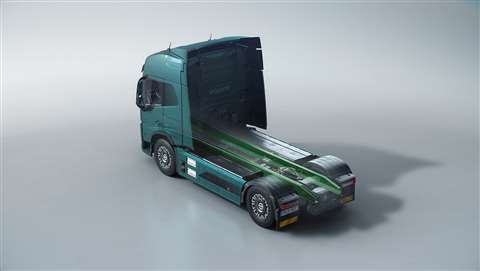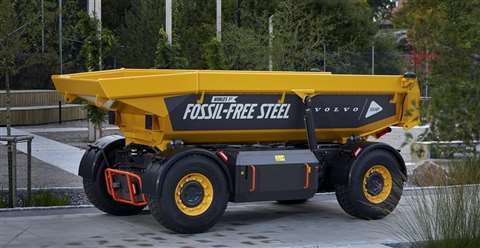Volvo to use fossil-free steel in trucks
24 May 2022
 Volvo said it is introducing fossil-free steel in its trucks. (Photo: Volvo Trucks)
Volvo said it is introducing fossil-free steel in its trucks. (Photo: Volvo Trucks)
Sweden’s Volvo Trucks said it is introducing fossil-free steel in its heavy-duty trucks, claiming to be the world’s first truck manufacturer to do so.
The steel is produced by the Swedish steel company SSAB, using a completely new technology based on hydrogen. The result is a much lower climate impact than conventionally produced steel, Volvo said. Small scale introduction of the steel in Volvo’s heavy electric trucks will begin in the third quarter of 2022.
“We will increase the use of fossil-free materials in all our trucks to make them net-zero not only in operation – but also when it comes to the materials they are built of,” says Jessica Sandström, senior vice president Product Management, Volvo Trucks.
 In late 2021, Volvo Construction Equipment showed a load carrier built with fossil-free steel. (Photo: Volvo CE)
In late 2021, Volvo Construction Equipment showed a load carrier built with fossil-free steel. (Photo: Volvo CE)
The first steel produced with hydrogen will be used in the truck’s frame rails, the backbone of the truck upon which all other main components are mounted. As the availability of fossil-free steel increases, it will also be introduced in other parts of the truck.
Today, around 30% of the materials in a new Volvo truck come from recycled materials and up to 90% of the truck can be recycled at the end of its life, Volvo Trucks said.
“We are continuously striving to further minimize our climate footprint. We are also moving towards greater circularity in both our operations and our trucks,” said Sandström.
Volvo Group has been collaborating with SSAB on fossil-free steel since 2021. Last October, Volvo Construction equipment showed a load carrier for mining and quarrying, that was built using fossil-free steel from SSAB.
STAY CONNECTED




Receive the information you need when you need it through our world-leading magazines, newsletters and daily briefings.
POWER SOURCING GUIDE
The trusted reference and buyer’s guide for 83 years
The original “desktop search engine,” guiding nearly 10,000 users in more than 90 countries it is the primary reference for specifications and details on all the components that go into engine systems.
Visit Now
CONNECT WITH THE TEAM











